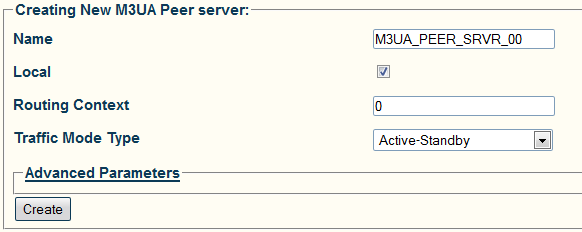Toolpack:Creating an M3UA Peer Server A
From TBwiki
(Difference between revisions)
| Line 1: | Line 1: | ||
| − | === '''''Applies to version(s): v2.5, v2.6.''''' === | + | === '''''Applies to version(s): v2.5, v2.6., v2.7''''' === |
{{DISPLAYTITLE:Creating an M3UA Peer Server}} | {{DISPLAYTITLE:Creating an M3UA Peer Server}} | ||
Now that you have create an M3UA peer signaling process (PSP), you must create a new Peer server. | Now that you have create an M3UA peer signaling process (PSP), you must create a new Peer server. | ||
Revision as of 10:14, 15 July 2013
Applies to version(s): v2.5, v2.6., v2.7
Now that you have create an M3UA peer signaling process (PSP), you must create a new Peer server. A peer server is a logical entity on the IP network that is served by one or more PSPs.
To create an M3UA peer server:
1- Click Create New M3ua Peer Server in the M3UA network configuration window
2- Configure the new M3UA peer server:
- Enter a name for the peer server
- Check the Local box for local peer server (OPC). For remote peer server (DPC), do not check this box. (For signaling gateway, this option does not appear, SG uses only remote peer servers)
- Enter a value for the routing context (must be unique within a local or non-local server list. However, this value does not need to be unique across lists).
- Click Create
3- Verify that the "M3ua Peer server was successfully created" message appears
4- Associate the newly created peer server with a peer signaling process (PSP):
- Select a PSP from the list of available PSPs
- Click the "<<" button to associate the PSP with the peer server


